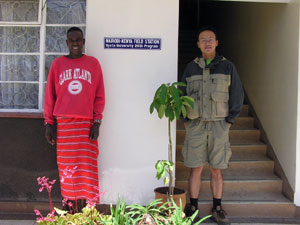| Period: 18 October - 6 November 2003. Country: Ethiopia, Kenya |
| |
Purpose of the Visit |
| |
To Attend the COE Field Station Cooperative Workshop
in Ethiopia, and Conduct On-Site Education in Kenya |
| |
OHTA Itaru (ASAFAS: Division
of African Area Studies) |
| |
Record of Activities |
| |
10/18 (Sat) |
 |
Kyoto – Nairobi |
| |
10/19 (Sun) |
 |
Nairobi – Addis Ababa |
| |
10/20 (Mon) – 31 (Fri) |
 |
Attended COE International Workshop held at Addis Ababa University,
and joined Field Study Tour in Ethiopia |
| |
11/1 (Sat) |
 |
Addis Ababa – Nairobi |
| |
11/1 (Sat) – 5 (Wed) |
 |
Conducted on-site education at Nairobi Field Station, and
engaged in maintenance of the Field Station |
| |
11/5 (Wed) |
 |
Nairobi – Kyoto (arrival on 11/6) |
| |
Outcome
and Progress Report |
| |
- (1) Field Station Cooperative Workshop
- The workshop
held at Addis Ababa University was titled “Environment, Livelihood
and Local Praxis in Asia and Africa.” Presentations were given by 16
graduate students of ASAFAS (12 from the Division of African Area Studies,
and 4 from the Division of Southeast Asian Area Studies) and 4 graduate students
of Addis Ababa University. The workshop, which continued for three days,
saw lively discussions. The students and teachers of ASAFAS stayed at the
same hotel, enabling us to have intensive time for learning together while
attending the workshop. It was also a rare chance for us to receive critical
comments of Ethiopian scholars, from various local perspectives, to the presentations
by the Japanese students. For a program and abstracts of the presentations,
and for details of Field Study Tour, please see, http://areainfo.asafas.kyoto-u.ac.jp/efs/e/workshop.html.
- (2) On-Site Education at Nairobi Field Station, and Maintenance
of the Field Station
- In Kenya, Mr.
Naoki Naito, an ASAFAS graduate student (year of enrollment: 1999), has conducted
field research on the “Formation of multiple ethnic identities among
the Ariaal pastoralists.” The Ariaal live between two distinct ethnic
groups, the Samburu and Rendille. The Rendille speak an Afro-Asiatic language,
while the Samburu speak a Nilo-Saharan one; the two are completely different.
The Ariaal do not have their own language, but are bilingual in the other
two. They have also adopted age and descent systems from the Rendille and
Samburu, modifying them for their convenience. Mr. Naito is exploring the
processes through which peoples' identities are created, negotiated,
and maintained in the boundaries between these three groups, and how regional
society is formed through these processes. He made a presentation at a seminar
held at the Nairobi Field Station. Professor Tanaka of ASAFAS also attended
the seminar, and we discussed Mr. Naito's pursuit of his research theme.
We are planning to
open a web page for the Nairobi Field Station in the near future. At the Station,
I set up an internet connection in order to make it possible to update the page
from the Station.
|
 |
|
 |
| Mr. Sun Xiaogang, a graduate student of ASAFAS, and Mr. Saimon, a Kenyan research assistant of another ASAFAS student, Ms. Kyoko Nakamura, in front of the Nairobi Field Station (photo by Mr. Sun). |
|
A herd of goats and sheep return in the evening from a day-trip herding. Young members of the Ariaal try to increase their livestock herds by giving priority to the raising of goats and sheep, which multiply faster than cattle and camels (photo by Mr. Naito). |
|
|
 Report
Report